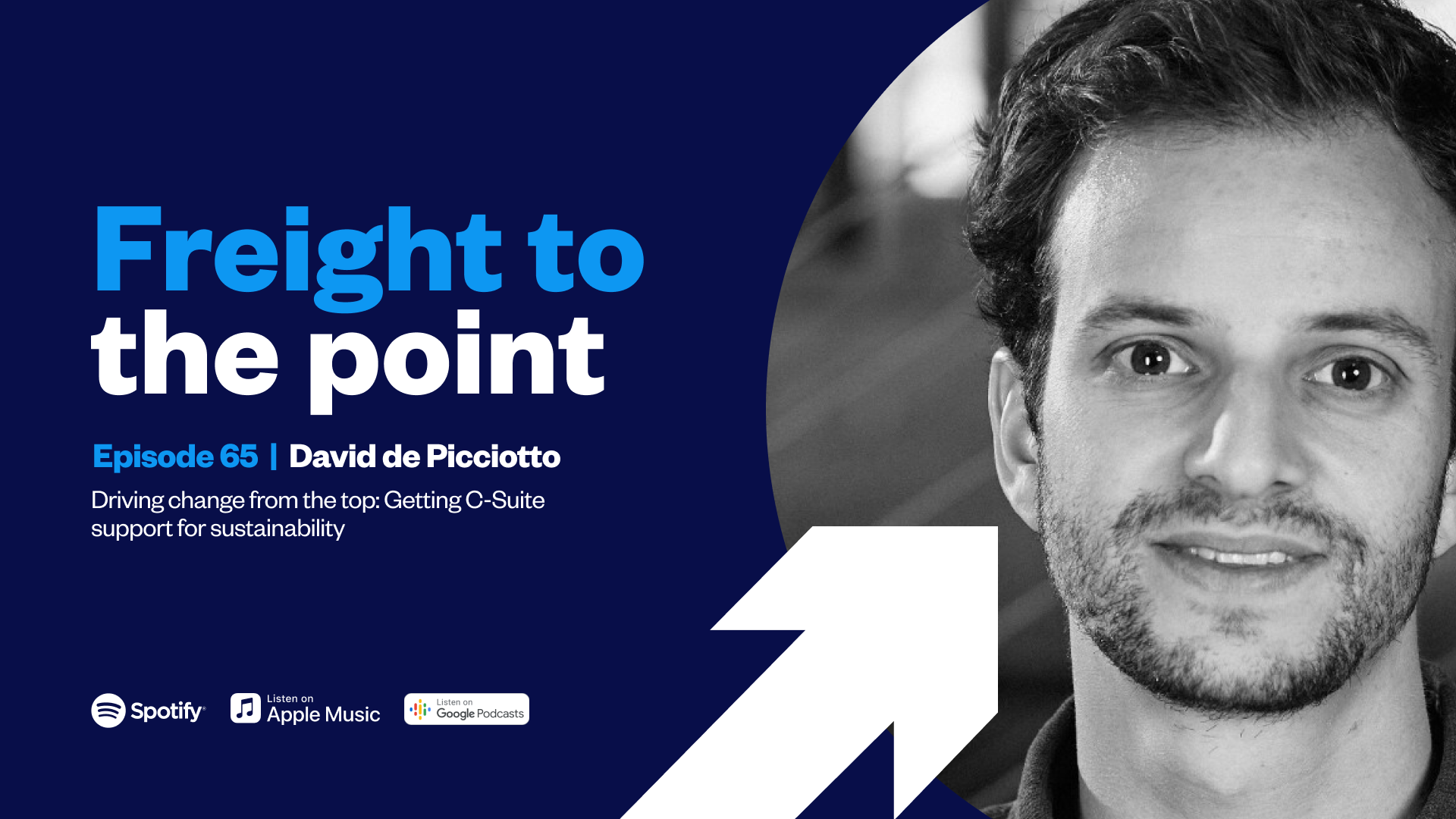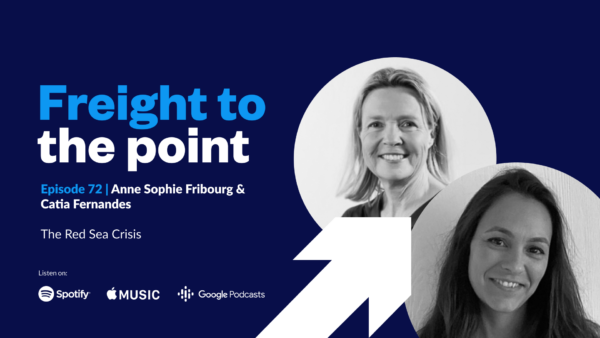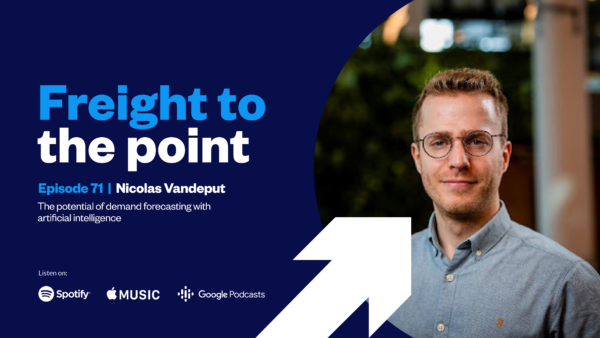Episode 65:
Driving change from the top: Getting C-Suite support for sustainability
See all episodes

Sustainability is a critical aspect of modern supply chain management, but achieving sustainable goals can be challenging. This is why it’s more important than ever to get the C-Suite involved.
By engaging the C-Suite in sustainability initiatives, it ensures that sustainability is integrated into the organisation’s strategy and culture, driving stakeholders across the supply chain towards more sustainable practices.
But how do you successfully engage the C-Suite in sustainability efforts?
Listen to our latest episode on Freight to the Point as Jasmine Bosenick, Head of GTM at Zencargo and David de Picciotto, CEO and Co-Founder at Pledge give their insights on how to create a compelling business case for sustainability to the C-Suite.
David de Picciotto
David is the Co-founder & CEO of Pledge, a climate software company helping decarbonise the logistics supply chain through its accredited and integrated platform. Founded in 2021 in the UK, Pledge is backed by institutional investors including Zinal Growth, Lowercarbon Capital and Visionaries Club.
Before Pledge, David worked for Partners Group, a global private equity firm, where he focused on growth equity investments and previously led International Expansion at Revolut, the UK FinTech. David is also the co-founder of media start-up iRewind, where he exited in 2016.
Resources
Jasmine Bosenick:
Hello everyone, and of course, welcome David to the Navigate main stage. I’m obviously personally delighted that you’re able to join me and discuss our topic for the day, which is driving change from the top and getting C-suite support for sustainability. Lots of alliteration in that title, I’ve just realised. I think we can all agree that sustainability is a really hot topic right now, but achieving sustainable goals can be challenging, which is why it’s important, more than ever, to get C-suite support and build out a comprehensive approach. So begs the question, where do we start? How do we successfully involve the C-suite in sustainability? Who better to join me for the session than David, Pledge’s CEO and Co-founder. David, why don’t we kick off the session with a quick introduction to yourself?
David de Picciotto:
Thanks for having me, Jasmine. Hi, everyone. I’m David, the co-founder and CEO of Pledge. By way of background, Pledge is a decarbonisation software for the transport and logistics sector, helping logistics and supply chain leaders meet their sustainability goals and automate Scope 3 emissions compliance.
Jasmine Bosenick:
Thank you, David. Let’s jump straight in. So I guess, let’s start quite high level. What I’m really interested to understand is, what does good look like when it comes to sustainability? What’s the dream state for businesses?
David de Picciotto:
So I think if we put this in the context of a company embarking on a sustainability journey, I think it’s, first of all, about understanding what you want to achieve and where you’re starting from. And then obviously to understand I need to know what is my current impact and where do I want to get to? And there are today, obviously, various tools to understand what’s your current impact through software and non-software solutions, and then it’s about defining a plan to set particular goals. If we put this in the context of certain carbon emissions, for example, and executing on that plan so that month after month, quarter after quarter, year after year, you start minimising and reducing your impact. And obviously sustainability is a very broad topic, but I think there are a couple of foundational elements which are important to demonstrate what good looks like as part of that process.
And these will start with the types of framework that a company might follow. There are obviously various more or less notable frameworks in carbon accounting, for example, or emissions reductions targets framework such as the Science-Based Targets Initiative, SBTI, which is a framework developed by various body including the UN, which set specific emissions reductions targets in line with the goals of the Paris Agreement. So that would be one way to start demonstrating what good looks like. But then it’s also about making sure that this progress that a company will embark on, is it auditable, is it verifiable? Which is often underpinned by systems with data. Is it transparent and am I accountable for the targets that I’ve put in place? Oftentimes we also see companies leveraging third parties to essentially demonstrate that more objective assurance as part of their sustainability journeys and objectives.
Jasmine Bosenick:
Thank you, David. No, it makes a lot of sense. I think one thing we always like to do with these sessions is really put ourselves in the shoes of our customers. If I imagine I’m a logistics or a supply chain manager and I’m talking to the C-level, where do you think I should start with making that case for sustainability?
David de Picciotto:
In my view, it’s not a question of if, but rather when will every single company in and outside of logistics will have to start taking action. So I think that’s obviously a good place to start. And this is principally driven by impending regulations. So if we think in the context of logistics supply chain, we have some regulations coming up next year such as CSRD, which stands for Corporate Sustainability Reporting Directives, which will be rolled out in Europe and require a host of companies, specifically listed companies to start reporting on their carbon emissions including supply chain emissions in 2025 based on 2024 data. So I think raising the awareness about these impending regulations will obviously help make the case internally. And then it’s a question of, well, do we want to be forward thinkers and start implementing initiatives to meet these upcoming regulations and to be compliant today and reap the additional benefits that come with it?
Or do we want to wait till the last minute and then rush to be compliant at this time? And when we think about, outside of regulations, the business benefits that companies can reap out of implementing sustainability initiatives, and there’s obviously the ability to elevate your brand and be seen as forward thinkers in the industry, especially if we think about high-emitting industries like transport and logistics, which represents about a fifth of global greenhouse gas emissions. But there’s also the ability to potentially differentiate your value proposition not only to customers, but also potentially to your employees who increasingly want to work in purpose-driven companies. And then maybe lastly, and that’s something less obvious, these new regulations or systems are complex, take time to implement, and so there probably are a lot of known/unknowns and unknowns and knowns in implementing these processes to become compliant. So the sooner you start, the more you mitigate the risk of missing deadlines when they’ll come up.
Jasmine Bosenick:
No, it makes a lot of sense. I completely agree. I know which side of the fence I’d rather be, either in the proactive camp or waiting for the change to come onto me as a business. I think it always makes sense to be on the front foot of any change and really embrace it and take it by the horns essentially. One thing I’d love to understand from you is when it comes to sustainability or any other major business shift for that matter, what do you think are, I guess, the key elements for that compelling business case?
David de Picciotto:
What I always like to look at is what’s the return on investments or the return on efforts of being compliant, for example? I think there are now various studies that have been published on the business benefits of sustainability around top as well as bottom line improvement, cost reduction, for example by shifting your energy mix to renewable sources. So I think that this is obviously always a good place to start, but also I think it’s important potentially to put the emphasis on less visible drivers for sustainability as I previously expressed. Such as the employee sentiment, the consumer sentiment, or end client sentiment, as well as maybe a less obvious one, which is the investor sentiment.
If you’re a listed company, some investors today, or an increasing proportion of investors have certain ESG mandates given by their own investors, which also applies in private markets when we put this in the context of pension funds requiring portfolio companies to have certain net-zero targets, who adhere to certain goals. So I think these are additional drivers that will eventually push companies to adopt these practices. And then the last one will be also just the snowball effect being created by an increasing number of companies in a given industry adopting sustainability practices and amplifying the message as a result, which will obviously force their peers or competitors to also follow suit.
Jasmine Bosenick:
Yeah, similar to the point we just made, it’s do you want to lead the way or do you want to forever be playing catch up? Moving away from I guess hypotheticals, many of these arguments, especially with, I guess, a C-suite audience come down to hard numbers. Maybe you can give me a couple of examples just to bring that to life for our audience at home.
David de Picciotto:
So when we speak to clients, typically logistics service providers, what we try to put forward is ask them, “Well, how many tenders in the past quarter from clients required you to demonstrate your sustainability credentials, be it either your sustainability credentials as a company and whether you have your own ESG agenda, net-zero targets and others? Or even potentially sustainability services that you can provide to your clients, such as measuring and reporting on multimodal supply chain emissions?” So I think trying to get into this cadence and providing these metrics and understanding, well, where are the WIN themes for sustainability? And the 10 last standards that we participated in will obviously start providing a view on this return on investment or return on efforts for implementing these initiatives. But maybe I should actually return the question to you, given obviously this is a topic that you’re increasingly facing, as I understand.
Jasmine Bosenick:
Yeah, a hundred percent. I think I’ve personally worked in tenders for the tenders large scale, big processes for the last 10 years. And I can’t emphasise the fact enough that things have really changed. Previously, I know you and I have spoken a lot about WIN themes before, I think sustainability for me is up there as one of the top three WIN themes today. I think previously everyone was focused on profit, people, planet, and there’s definitely a complete flip of that on its head and it’s now planet, people, profit. So I think, yeah, I couldn’t agree with you more on that one, to be honest.
David de Picciotto:
Yeah, and I think interesting. This is something that it’s going one direction, I think everybody will agree on that. I think it’s still very early in the maturity curve and we haven’t reached this tipping point where it’ll become ubiquitous. But if I compare to last year, at least, maybe when I was speaking to prospects last year, some of them told me, “Well, come back in five years when this will be a topic.” At least what I can say is that this year everyone recognises that sooner or later, i.e. within the next 12 months, and they’ll have to do something to demonstrate their sustainability credentials.
Jasmine Bosenick:
Absolutely. Which I guess actually leads nicely on to my next question, which is how can sustainability advocates in business create, I guess, commitments that go beyond the short term goals and embed sustainability in, I guess, the cultural change of the entire organisation? So from the C-level, all the way downwards.
David de Picciotto:
Like in every organisation, and that may be a bit of a broad statement, but I think it starts with what you stand for as a company. And yes, maybe transport logistics is not the greenest industry out there, but it’s obviously a critical one. But yeah, it starts with what you stand for as a company, and this begins with your company’s mission statement. Why do you exist and your company values? And then everything essentially flows from that down to your OKR, objective and key result system, or other periodic goal setting system that you have in place. And potentially also then how from these OKRs can you tie certain sustainability KPIs, even if it’s not necessarily part of a sustainability function? Maybe your operations team might have certain sustainability key results that will feed into your wider company objectives.
And then maybe more tactically also, it’s about how you embrace these values as part of your day-to-day. Another way that we’ve seen companies engage their teams internally around the topic of sustainability, it’s about being very transparent with respect to the initiatives that are being implemented internally or externally with clients. And that often finds its roots in data-driven processes of software that are accessible by the organisation or that the C-suite is reporting on a periodic basis as part of town halls or periodic company events with their teams.
Jasmine Bosenick:
Thank you, David. Certainly lots of tips and things and lots of stuff for everybody on this call to think about, especially when it comes to regulation. I think one thing that I’ve certainly taken away from our session is when to start, and for me it’s now. If you wait, I think you’re going to be forced to act, and by default if you’re forced to act, you will be on the back foot rather than on the front foot. David, as always it’s… Go on.
David de Picciotto:
On that point, I think it’s obviously great to want to kickstart the sustainability journey, but we obviously live with a current economic context that’s not easy for businesses and especially if you’re not necessarily at the board level, you obviously have your day-to-day job. So it often comes down to understanding the incentives of everyone in your organisation. And that’s why I think it’s critical to start setting the sustainability agenda at the top level and at the strategy level so that it can really flow down. Because anecdotally, when I speak to clients or prospects, there’s always somebody in the organisation that wants to implement some sort of sustainability initiative. Oftentimes the champion just doesn’t have the buy-in from the management or from the direct manager to implement that initiative. So really to reinforce my earlier points, I think everything starts at the company or board level.
Jasmine Bosenick:
A hundred percent agree. And do you think that… I think with sustainability can sometimes feel like, “Oh my God, there’s so much to think about. There’s all of this regulation, all of this stuff that I need to do.” It’s quite overwhelming. I guess, depending on where you are in your sustainability journey, where would you recommend… Assume I haven’t started and I’m very much at the beginning of my journey, where would you recommend I focus and start?
David de Picciotto:
I always try to find the path of least resistance and try to find these lowest hanging fruits. And obviously that will vary very much from business to business. So subject to your resources, I think the first thing to understand is what is our knowledge of the topic? Do we have someone internally that is familiar with the topic, who wants to learn about the topic? Or do we have to hire a consultant or a third party, maybe a software, to help us on that journey? Because I think obviously without that foundational knowledge, you won’t be able to take the right action and understand what will be more or less resource intensive. So I think it’s just about being aware and having that foundational knowledge before starting to make a decision.
Jasmine Bosenick:
Thank you, David. It’s been obviously an absolute pleasure to host you at Navigate, and thank you for sharing your insights and wealth of knowledge on sustainability. Personally, I found it super helpful. I’m sure our audience at home has as well. Before we wrap up our session, I’ve just got a couple of Q and As, if I may. I’m just going to open it up one moment. So I’ve got a question. Are there any particular metrics which are useful for gaining C-suite support?
David de Picciotto:
Yeah, I think that’s a great question. So if I go back to the example of proving the return on investment or the return on efforts, if I put this in the context of satisfying client demand, if there are any sustainability initiative that are tied to customer demand, one of the great way to obviously prove that is to demonstrate, “Well, how many new tenders have we won?” So what new business have we won or how many existing clients have we’ve been able to retain? Or maybe even from how many clients have we been able to increase share of wallets? Or how many more shipment volume have we been able to capture from that given client? So these would be some of the metrics that I would start looking into.
Jasmine Bosenick:
Brilliant. Thank you, David. I think that’s all from our Q and A that I can see. I will hand back over to Lucy for our next session.

Episode 72: The Red Sea Crisis
In the latest episode of Freight to the Point, we’ve featured our most rec...

Episode 71: The potential of demand forecasting with artificial intelligence
In the most recent instalment of Freight to the Point, Lucie Phillips, Zen...

Episode 70: Rates: What's next for 2024?
As we prepare for the year ahead, it's crucial to consider the three pillars...

